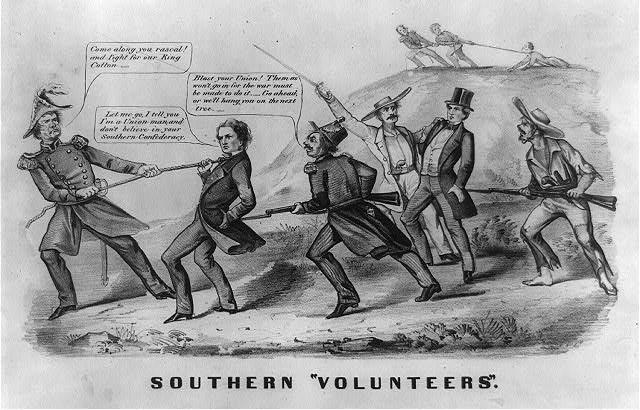Civil War Conscription Cartoon
The print may have appeared soon after the Confederate Congress passed a national conscription act on April 16, 1862, to strengthen its dwindling army of volunteers. The artist characterizes regular Confederate troops as unsavory, criminal types. Two of them (in uniform, left and center) have a well-dressed young gentleman in tow. The leader pulls on a rope around the reluctant recruit's neck, saying, "Come along you rascal! and fight for our King Cotton." The man protests, "Let me go, I tell you I'm a Union Man, and don't believe in your Southern Confederacy." He is prodded by the bayonet of a second soldier, gin flask protruding from his pocket, who urges, "Blast your Union! Them as won't go in for the war must be made to do it. Go ahead, or we'll hang you on the next tree." A second group follows. Two men in wide-brimmed hats have seized another gentleman, and urge him at bayonet point toward the left. One of the men, barefoot and ragged, with a knife and pistol in his belt, resembles a Mexican bandit. Atop a nearby hill two soldiers drag a third civilian along the ground by a rope around his neck. The print is comparable in both style and political sympathy to contemporary prints by Currier & Ives, such as "Re-Union on the Secesh-Democratic Plan" (no. 1862-10). - Library of Congress

Currier & Ives. Southern "volunteers." ca. 1862. Lithograph. 23.8 x 36.9 cm. American Cartoon Print Filing Series, Library of Congress Prints and Photographs Division, Washington, D. C. https://www.loc.gov/item/2008661642/
Public Domain
Public Domain is a copyright term that is often used when talking about copyright for creative works. Under U.S. copyright law, individual items that are in the public domain are items that are no longer protected by copyright law. This means that you do not need to request permission to re-use, re-publish or even change a copy of the item. Items enter the public domain under U.S. copyright law for a number of reasons: the original copyright may have expired; the item was created by the U.S. Federal Government or other governmental entity that views the things it creates as in the public domain; the work was never protected by copyright for some other reason related to how it was produced (for example, it was a speech that wasn't written down or recorded); or the work doesn't have enough originality to make it eligible for copyright protection.